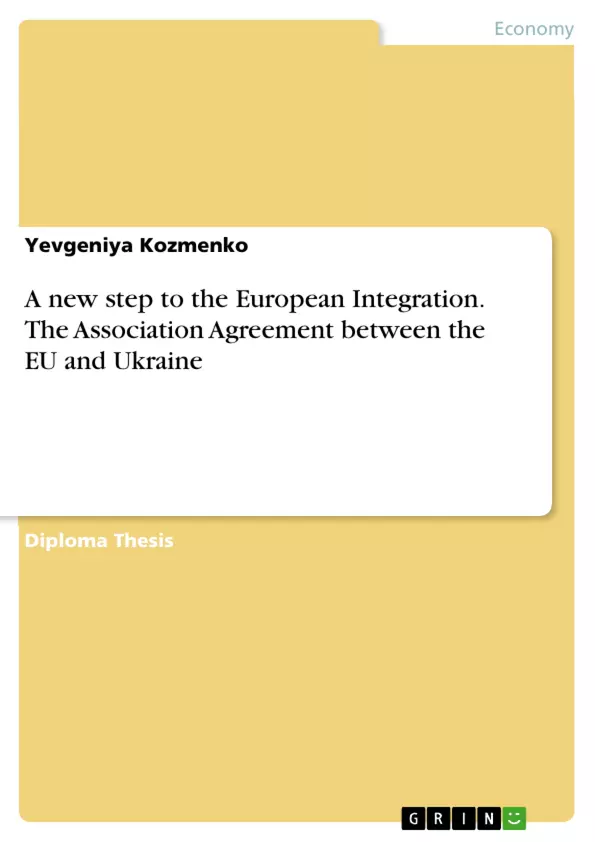The Association Agreement, which was signed between the European Union and Ukraine in 2014, opened a big discussion about new challenges in Europe. Many European countries signed similar Agreements and became very quickly therafter full members of the EU. Nowadays there are a lot of opinions and myths about what exactly the Ukrainian Association is, and, in general, where it should bring Ukraine and Europe.
This research paper explores the objectives pursued by the EU and Ukraine by the time they signed the Agreement. It provides a full analysis and interpretation of its content and describes how Ukrainian attempt to get closer to the European Union changed the geo-political situation in Europe. This paper is important as it will cast in light the background of the present tragical events in Ukraine and will provide deeper knowledge about the situation.
The main hypotheses of this work are as follows:
1. The Association Agreement between Ukraine and the EU does not give any guarantees for the accession to the EU and could only be seen as the basis of a prospective future membership.
2. The access to the European integration of Ukraine in the EaP is precluded because of inflexible and “naive” policy of the EU. The ENP has failed and needs to be reconsidered.
3. Russian permanent intervention in the policy decision-making of Ukraine slowdowns its integration towards Western Europe.
The paper will be a mixture of description and “data followed by analysis”, going gradually more in depth from the negotiation process to the conclusion of the AA between Ukraine and the EU. To make the argument easy to follow, chronological analysis will be used in dealing with the interval of 2007-2015 (from the beginning of negotiations to the implementation process of the AA).
Inhaltsverzeichnis (Table of Contents)
- Abstract
- Acknowledgements
- List of abbreviations
- Chapter 1: Introduction
- 1.1. Background of the Study
- 1.2. Problem Statement
- 1.3. Research Questions
- 1.4. Structure of the Thesis
- Chapter 2: Theoretical Framework
- 2.1. Theories of Integration
- 2.2. Theories of Regionalism
- Chapter 3: The European Union and its Policies towards Ukraine
- 3.1. European Integration of Ukraine: A Historical Perspective
- 3.2. The European Neighborhood Policy (ENP) and Ukraine
- 3.3. The Eastern Partnership (EaP)
- Chapter 4: The Association Agreement between the EU and Ukraine
- 4.1. The Negotiations of the Association Agreement
- 4.2. Key Provisions of the Association Agreement
- 4.3. The Deep and Comprehensive Free Trade Area (DCFTA)
- Chapter 5: Impact of the Association Agreement
- 5.1. Economic Impact
- 5.2. Political Impact
- 5.3. Social Impact
- Chapter 6: Challenges and Opportunities of the Association Agreement
- 6.1. Challenges for Ukraine
- 6.2. Challenges for the EU
- 6.3. Opportunities for Ukraine
- 6.4. Opportunities for the EU
Zielsetzung und Themenschwerpunkte (Objectives and Key Themes)
The thesis aims to provide a comprehensive analysis of the Association Agreement signed between the European Union and Ukraine in 2014. It examines the objectives of both parties, analyzes the content of the agreement, and investigates its impact on both Ukraine and the EU.
- European integration of Ukraine
- EU's policy towards Ukraine
- The Association Agreement: content and impact
- Economic, political, and social consequences of the agreement
- Challenges and opportunities for both Ukraine and the EU
Zusammenfassung der Kapitel (Chapter Summaries)
Chapter 1: Introduction provides the background of the study, defines the problem statement and research questions, and outlines the structure of the thesis.
Chapter 2: Theoretical Framework presents the relevant theories of integration and regionalism, providing a theoretical context for the analysis of the Association Agreement.
Chapter 3: The European Union and its Policies towards Ukraine traces the historical evolution of EU-Ukraine relations, focusing on the European Neighborhood Policy and the Eastern Partnership.
Chapter 4: The Association Agreement between the EU and Ukraine details the negotiation process, key provisions, and the Deep and Comprehensive Free Trade Area (DCFTA).
Chapter 5: Impact of the Association Agreement examines the economic, political, and social implications of the agreement for both Ukraine and the EU.
Chapter 6: Challenges and Opportunities of the Association Agreement discusses the challenges and opportunities faced by both Ukraine and the EU in implementing the agreement.
Schlüsselwörter (Keywords)
The main keywords and focus topics of the thesis include: European integration, Ukraine, European Union, Association Agreement, Deep and Comprehensive Free Trade Area (DCFTA), Eastern Partnership, European Neighborhood Policy, economic impact, political impact, social impact, challenges, opportunities.
- Quote paper
- Yevgeniya Kozmenko (Author), 2015, A new step to the European Integration. The Association Agreement between the EU and Ukraine, Munich, GRIN Verlag, https://www.grin.com/document/336676



